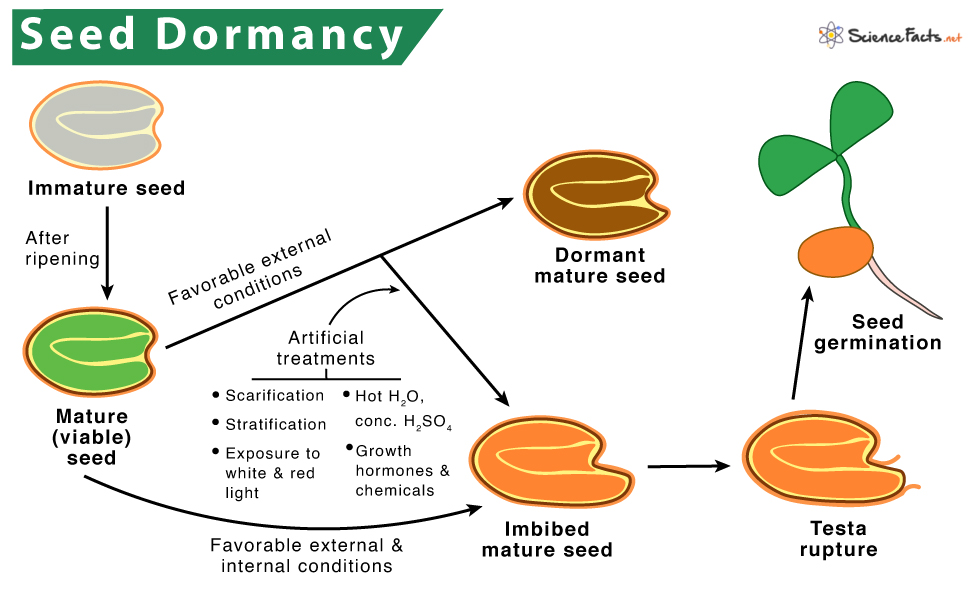Seed dormancy is defined as the inability of a viable seed to germinate under conditions favorable for germination. These conditions are the combination of light, water, oxygen, temperature, humidity, gases, mechanical restrictions such as types of the seed coat and hormones. The period of seed dormancy may vary from days to months and even years. It is also sometimes called the ‘rest or quiescent period’ in plants.
Causes of Seed Dormancy
Types of Seed Dormancy
Methods of Breaking Seed Dormancy
Advantages and Disadvantages of Seed Germination
Light: Seeds of most plants germinate equally well in light and darkness. Seeds of plants such as lettuce remain dormant during darkness and germinate if they are exposed to light. Thus, darkness inhibits germination in those plants. In contrast, seeds of Nemophila and Silene species remain dormant when exposed to light. They germinate only in total darkness.Temperature: Normally, low temperature promotes germination, and high temperature induces dormancy in most plants. Seeds of temperate plants such as apple, walnut, and pinus remain dormant if not exposed to chilling temperature (1°- 5°C) over an extended period (nearly a week). Exceptions like desert plants require extreme high temperature (60°-70°C) during daytime and shallow temperature (5°-10°C) during the night to start germination.Presence of Tough Seed Coat: Seeds of leguminous plants such as pea, beans, clovers, alfalfa, water lotus, and morning glory have tough seed coats. Seeds of such plants prevent the entry of water inside the seed, thus preventing their germination. Also, a hard coat obstructs the exchange of gases like oxygen, necessary for seed respiration.Immature (Rudimentary) Embryo: Seeds of orchids such as ginkgo (Ginkgo biloba), European ash (Fraxinus), and holly (Ilex) has immature embryo when the seed is shed. Such plants do not germinate until they attain full maturity.Presence of Inhibitory Chemicals: Several naturally occurring compounds like ascorbic acid, ferulic acid, and coumarin are found in the embryo (e.g., in Xanthium), endosperm (e.g., in Iris), or in the seed coats (e.g., in Cucurbita) induces seed dormancy.
- Exogenous Dormancy Factors outside the embryo induce this type of dormancy. Here, the tissues enclosing the embryo affect germination by preventing water uptake, limiting the entry of oxygen to the embryo, providing mechanical resistance to embryo expansion and the emergence of radical, supplying inhibitors, and preventing the leaching of the inhibitors.
- Endogenous Dormancy This type of dormancy is induced because of chemical changes within the seed’s embryo. One reason for a plant to not germinate during endogenous dormancy is that the embryo is underdeveloped at maturity.
Based on the Surrounding Conditions of the Seed
- Innate Dormancy: It is a condition when seeds cannot germinate even when exposed to favorable growth conditions. The inability is sometimes due to the embryo being immature at the time of germination. Innate dormancy can also be imposed chemically by inhibitory compounds in the seed coat or the embryo.
- Enforced Dormancy: Found when seeds are deprived of favorable growth conditions such as sufficient moisture, oxygen, light, and suitable temperature. In enforced dormancy, no physiological mechanism is involved in inducing dormancy. The seeds are said to be in the ‘quiescent’ stage.
- Induced Dormancy: Caused by extremely unfavorable growth conditions. Such plant species have no innate dormancy but acquire them with time. After a certain period, the seeds permanently fail to germinate.
- Methods to Break Dormancy of Seeds with Hard Seed Coat
- Methods to Break Dormancy of Light Sensitive Seeds
- Methods to Break Dormancy of Temperature Sensitive Seeds
Helping seeds overcome adverse growth conditions (such as severe cold and water stress) is injurious for their vegetative and reproductive growth. Seed germination is thus is a survival strategy in plants.Ensuring seeds to germinate only under favorable growth conditionsStoring seeds without losing their viability for later use. Dormancy helps seeds to remain viable in the soil for several years, providing a continuous source of the new plant even after natural calamities such as flooding, earthquakes, or draught.Preserving the gene pool thus preventing plant species from getting extinctPreventing in-situ germination (vivipary) of seed. Dormancy is necessary for cereal crops. If they germinate immediately after harvest, they will become unfit for human consumptionEnsuring proper dispersal of seeds to distant places
Disadvantages
Preventing germination of seeds immediately after attaining maturityPreventing uniform emergence of seedlingsCreating difficulty to maintain plant populationInterfering with seed-testing procedures, thus causing problems to seed analystsAllowing noxious weed seeds to germinate that remain dormant for many years in the soil, thus interfering with the growth of crop plantsAffecting uniform germination in dormancy revoked seeds
